

Casein Allergy Information. Part 1 of 6: Overview What is a casein allergy?
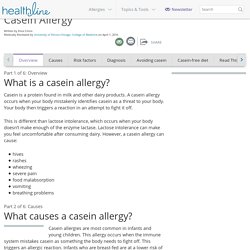
Casein is a protein found in milk and other dairy products. A casein allergy occurs when your body mistakenly identifies casein as a threat to your body. Your body then triggers a reaction in an attempt to fight it off. This is different than lactose intolerance, which occurs when your body doesn’t make enough of the enzyme lactase. Hivesrasheswheezingsevere painfood malabsorptionvomitingbreathing problems Part 2 of 6: Causes What causes a casein allergy? Casein allergies are most common in infants and young children. Usually, a casein allergy will go away by the time a child reaches 3 to 5 years of age.
Where is casein found? Mammal’s milk, such as cow’s milk, is made up of: lactose, or milk sugar fatsup to four kinds of casein protein other kinds of milk proteins The amount of each of these substances in milk depends on: Many dairy products contain casein, but not all do. Low-fat milk yogurt kefir cheese ice cream. Casein Allergy Information. A Page for the Milk Allergic. LAST UPDATED: June 17, 2011.
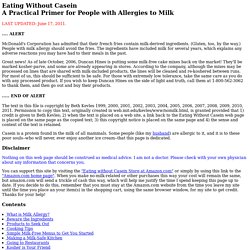
McDonald's Corporation has admitted that their french fries contain milk-derived ingredients. (Gluten, too, by the way.) People with milk allergy should avoid the fries. The ingredients have included milk for several years, which explains any adverse reactions you may have had to their meals in the past.
Great news! A Page for the Milk Allergic. LAST UPDATED: June 17, 2011.
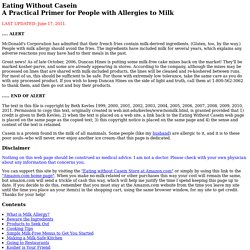
McDonald's Corporation has admitted that their french fries contain milk-derived ingredients. (Gluten, too, by the way.) People with milk allergy should avoid the fries. The ingredients have included milk for several years, which explains any adverse reactions you may have had to their meals in the past. Great news! The text in this file is copyright by Beth Kevles 1999, 2000, 2001, 2002, 2003, 2004, 2005, 2006, 2007, 2008, 2009, 2010, 2011.
Casein is a protein found in the milk of all mammals. Disclaimer Nothing on this web page should be construed as medical advice. You can support this site by visiting the "Eating without Casein Store at Amazon.com" or simply by using this link to the "Amazon.com home page". Contents. What Is Casein? Foods With Casein, Casein Allergies, and More. Milk or Casein Allergy Prevention continued...
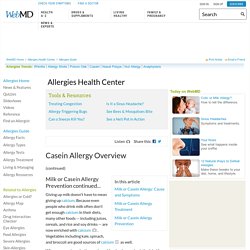
Giving up milk doesn't have to mean giving up calcium. Because even people who drink milk often don't get enough calcium in their diets, many other foods -- including juices, cereals, and rice and soy drinks -- are now enriched with calcium. Vegetables including kale, spinach, and broccoli are good sources of calcium as well. Whenever you're selecting packaged foods, always check the label for milk ingredients -- even with foods like luncheon meats and candy. In addition to casein, ingredients and foods to watch for and avoid include: Milk Proteins and Allergy Medications. Dr.
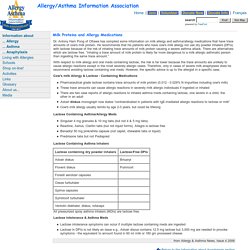
Antony Ham Pong of Ottawa has compiled some information on milk allergy and asthma/allergy medications that have trace amounts of cow's milk protein. He recommends that his patients who have cow's milk allergy not use dry powder inhalers (DPIs) with lactose because of the risk of inhaling trace amounts of milk protein causing a severe asthma attack. There are alternatives which are lactose free. “Inhaling a trace amount of milk protein is likely far more dangerous to a milk allergic asthmatic person than ingesting the same trace amount.” With respect to milk allergy and oral meds containing lactose, the risk is far lower because the trace amounts are unlikely to cause allergic reactions except in the most severely allergic cases. Milk Proteins and Allergy Medications. The Internet Drug Index for prescription drugs, medications and pill identifier. What Is Casein? Foods With Casein, Casein Allergies, and More.
Blue Zones. By Dan Buettner Life expectancy of an American born today averages 78.2 years.
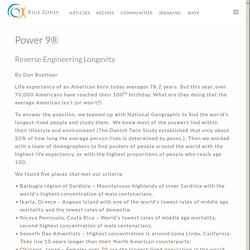
But this year, over 70,000 Americans have reached their 100th birthday. What are they doing that the average American isn’t (or won’t?) To answer the question, we teamed up with National Geographic to find the world’s longest-lived people and study them. We knew most of the answers lied within their lifestyle and environment (The Danish Twin Study established that only about 20% of how long the average person lives is determined by genes.). We found five places that met our criteria: We then assembled a team of medical researchers, anthropologists, demographers, and epidemiologists to search for evidence-based common denominators among all places. 1. The world’s longest-lived people don’t pump iron, run marathons or join gyms. 2. The Okinawans call it “Ikigai” and the Nicoyans call it “plan de vida;” for both it translates to “why I wake up in the morning.” 3.
Even people in the Blue Zones experience stress. AEB Search Results - QuantumOnline.com. Event App.